South Africa. Durban. Missed opportunities to divert ships to avoid Houthi attacks.
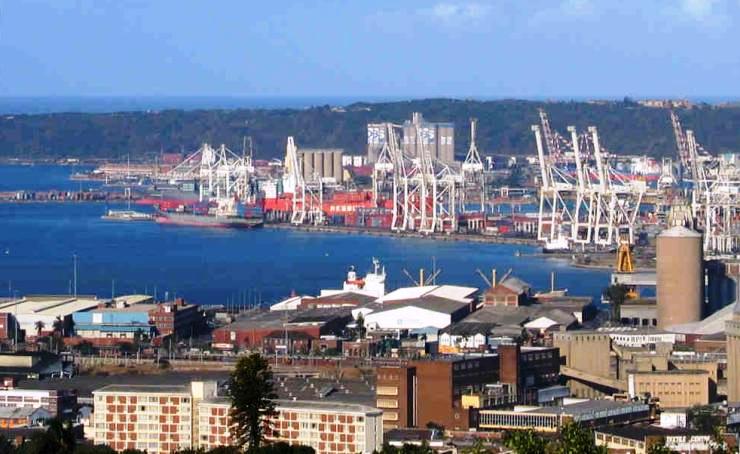
As Africa’s largest port, Durban faces many challenges that are hampering its development. These include congestion, lack of reform and competition from other regional ports.
Managed in a landlord capacity by the Transnet National Ports Authority (TNPA), the port of Durban is the largest in Africa. It has strong maritime connections with the rest of the world and a unique geographical location on one of the world’s busiest international routes between the Indian Ocean and the Atlantic. During the fiscal year 2023/2024 , the volume targets were 81.4 million tons for the bulk cargo and 826,033 automotive units. The port also hosts facilities for the fishing industry, shipyards, cruise liner vessels and recreational boating.
Durban is also the second main container port of Africa after Tangier-Med in Morocco, with a target of 4.2 million Twenty-Foot Equivalent units (TEU) in 2023/2024.
Established in July 1977, the Durban Container Terminal operates as two terminals Pier 1 and Pier 2, handling 65% of South Africa’s (SA) container volumes.Yet, the port of Durban is facing a number of serious challenges which threaten its development and efficiency. The most important is the congestion of the harbour.
According to UNCTAD’s Review of Maritime Transport in 2020, the median stay in South African ports was 3.32 days in average as against in 2.02 neighbouring Mozambique and 1.05 in Namibia. The World Bank’s 2022 Container Port Performance Index (CPPI) ranked Mozambique’s Beira Port (a private joint-venture between Mozambique Ports and Railways and Rotterdam-based Cornelder Holdings) as the most efficient in Southern Africa.
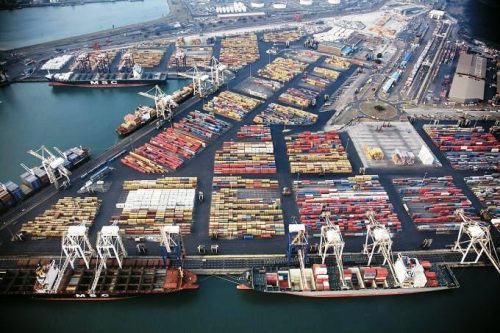
Aerial view of the Durban container port. CC BY-SA 2.0/ Media Club – IMC-KZN-00074G
Durban ranked 341 out of 348 global ports. In Southern Africa, Beira (Mozambique) ranked much higher (223) followed by Maputo (Mozambique), Port Elizabeth (South Africa), Walvis Bay (Namibia), Luanda (Angola) and Ngqura (South Africa).
One of the main problems is outdated and insufficient port equipment which according to the Organisation for Economic Cooperation and Development (OECD), means that despite its dominant position in Africa, the performance of Durban is sub-optimal. The port is one of the most expensive in the world, basically due to high cargo dues.
A World Bank report published in May 2021, ranked the Ports of Cape Town, Ngqura and Durban as among the worst ports in the world in operational efficiency. Moreover, a worrying aspect, underlined by the report SA-TIED (South Africa-Towards inclusive economic development) published in 2021 with the support of the United Nations, the European Union, the South African government and local and international research institutes, is that the average terminal efficiency of South African container ports has decreased from 76 to 66% between 2010 and 2019 while regional and global peers increased from 67% to 88%. Weather conditions may also worsen the situation. In January 2024, 100 km-an-hour winds have indeed interrupted container operations across the Durban, Cape Town, Ngqura and Port Elizabeth container terminals during two weeks, with 63 vessels kept waiting before Durban. In addition, the landlord authority, the TNPA has done little to stimulate competition between its ports.
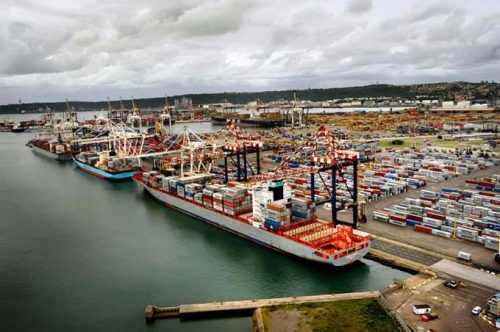
The port of Durban is facing a number of serious challenges. The most important is the congestion of the harbour. Courtesy Transnet Port Terminals
Durban and the other South African ports are also increasingly facing the competition of other regional ports and corridors. One of them is Walvis Bay, in Namibia, which competes with Lobito (Angola) and the South African ports for the evacuation of products from the landlocked countries and regions of Southern Angola, Katanga, Malawi, Zambia, Zimbabwe and Botswana as well as the Northern Cape province in South Africa. By 2025, it is planned that 2 million tons will be evacuated through the Walvis Bay-Ndola-Lubumbashi Development Corridor, 9 million more through the Trans-Kalahari Corridor from Angola, Botswana, and South Africa and 6 million through the Trans Orange corridor from South Africa.
The container capacity at Walvis Bay is being expanded from 350,000 TEU to 850,000 TEUs in 2025 and to 2.2 mil in 2045. It will enable it to become the first port of large container ships on the West Coast in the southern hemisphere. Due to a favourable business environment, the time required for customs clearance is shorter there (2 days) than in South Africa (5 days). Yet, Durban still retains a comparative advantage. The leasing price of land for warehouse is cheaper than in Walvis Bay.
The Angola port of Lobito is another potential competitor. Indeed, the Democratic Republic of Congo, Angola and Zambia are trying to revive the Lobito corridor with a support from the United States and the European Union which considers that connecting the Zambian and Congolese Copperbelt with the Atlantic is a geopolitical move in their race against China which dominates the strategic supply chains for the energy transition. One of the advantages for mining houses in both the DRC and Zambia is that the distance between the mining capital of Kolwezi (DRC) to Lobito is only 1,600 km or half the distance to Durban.
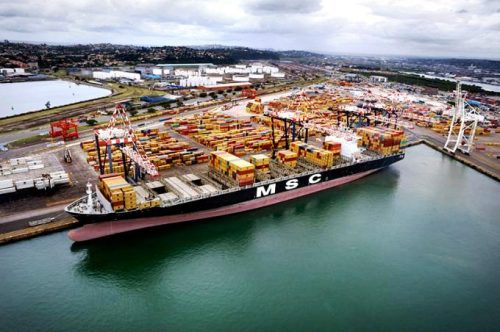
Durban and the other South African ports are also increasingly facing the competition of other regional ports and corridors. Courtesy: Transnet Port Terminals
The Lobito corridor has a railway line which was entirely rehabilitated in 2019 by a subsidiary of the China Railway Construction corporation until the Congolese border. In July 2023, the DR Congo and Angola officially granted a 30-year concession to the Lobito Atlantic Railways consortium to operate, manage and maintain the line, between Lobito and the DRC’s Copperbelt. This consortium, led by Singapore-based commodity trader Trafigura, which includes Portuguese construction firm, Mota-Engil and Belgian railway operator Vecturis, will invest up to US$555 million in the project.The promotors are banking on the booming demand for critical minerals necessary for the world’s transition to clean energy to attract investment in the region since the International Energy Agency projects that demand for rare earth metals – primarily for electric vehicle motors and wind turbines – will grow by three-to-seven-fold by 2040. Likewise, according to IEA, the demand for copper will increase by 40%, nickel and cobalt by 60-70% and lithium by almost 90%.Trafigura says the Lobito Corridor will offer the DRC and Angola the fastest export route
to Europe and the Americas.
So far, the DR Congo has been relying on three routes for its exports of metals and minerals: to Dar es Salaam (Tanzania), Beira (Mozambique) and Durban. But all are congested. The US International Development Finance (DFC) has conducted due diligence for a potential financing package of U$ 250 million for the project announced by President Joe Biden at the May 2023 G7 meeting in Japan. Yet, there is a bottleneck on the Lobito corridor: indeed, 400 km of railway to the mining town of Kolwezi on the Congolese side badly need to be rehabilitated and by early 2024, the investment had still to be secured.
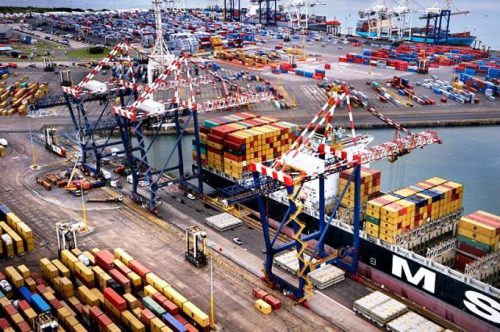
One of the main problems of the Durban Port is outdated and insufficient port equipment. Courtesy: Transnet Port Terminals.
In order to face all these challenges including the competition of other regional harbours, and the address the country’s ports operation problems, the South African government decided in 2021 to create a clear separation between the roles of the infrastructure owner, which is the Transnet National Ports Authority, and the terminal operator, which is Transnet Port Terminals. The purpose was that the functional and legal separation of these roles, which were operating divisions of the same company, would enable each to be fulfilled more independently and with greater efficiency. Among other projects for the ten coming years, the Ports Authority decided to deepen the entrance channel of Durban harbour and widen it from 122 to 230 meters. In January 2024, the TNPA announced plans to privatise several aspects of South Africa’s port operations. To this end, it hired a team of contractors to run the eight terminals that lack operators.
The TNPA hopes that this arrangement, which will last for three years, will smooth the transition to new long-term operators for the terminals. Yet, the reform is a delicate one since powerful dockers unions which fear job losses are hostile to such privatisation.
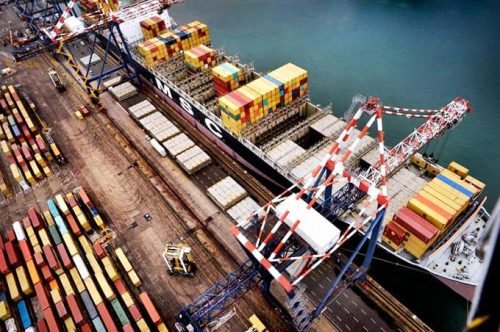
Durban is the most advanced and largest port in Africa.Courtesy: Transnet Port Terminals
These port improvements announced by the TNPA come at a time when large numbers of ships are being routed around the Cape of Good Hope to avoid hostilities in the Red Sea where Houthi militants in Yemen are targeting Israeli-linked vessels in solidarity with the Palestinians in Gaza. By the 24 December 2023, 125 ships had been diverted from the Suez Canal around Cape Town. But the congestion problems of South African ports mean that shipping companies face difficult choices over where to refuel and restock, analysts say.
Durban is the most advanced and largest port in Africa, so ships rerouting around the continent have not many choices for berthing for replenishment, despite its congestion says a logistics consultant. But when they can, vessels routed around the Cape which need for bunkering in route, are trying to do so either in Walvis Bay or in Port Louis (Mauritius) depriving Durban and other South African ports from business opportunities, say shipping line companies sources. (Open Photo: Harbour of Durban. CC BY-SA 3.0/ below)
F.M.



